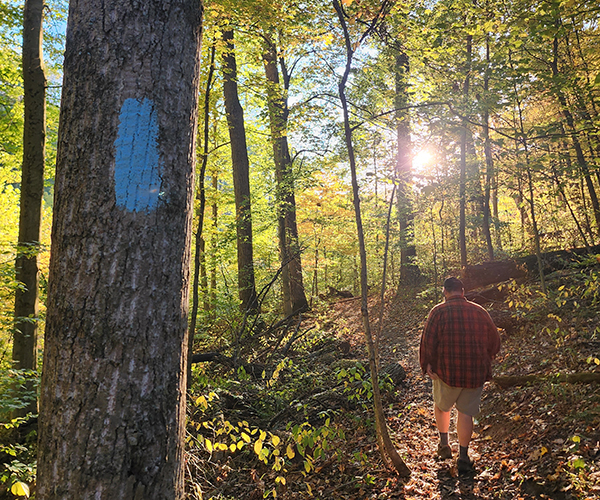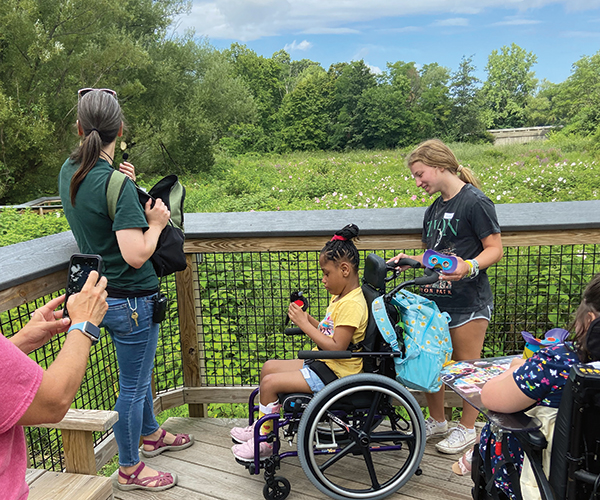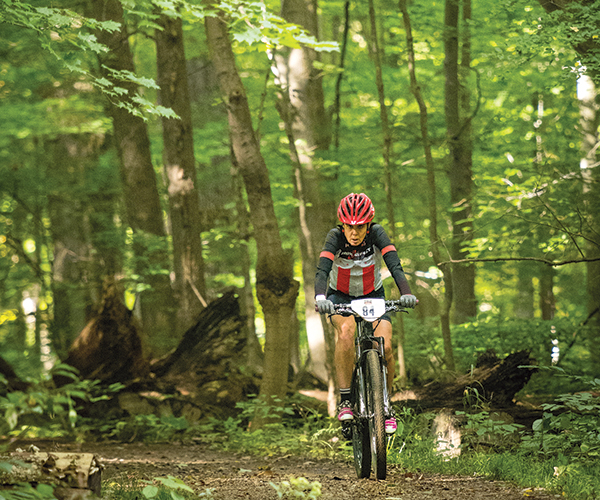The upper Gauley River in West Virginia is 48 degrees Fahrenheit and whipping along at 1,100 cubic feet per second on the day my raft flips on Iron Ring.
“We’re approaching our fourth big rapid,” warns river guide Ben Sutton of Class VI River Runners. My buddies and I have already managed to survive three huge sets of Class V rapids on this, Day Two of our “dueling rivers” package. Iron Ring, named after part of a log flume that was there in the early 1900s, is yet another monster.
When I first saw the Gauley this morning, it was narrower and steeper than I expected, with nearly continuous rapids and frequent boulders. The roar of unseen whitewater began to tie my stomach in knots. Even in a wet suit with polypropylene long johns and a paddle jacket, the water is shockingly cold.
“Oh shit,” Carole Miller mutters under her breath. She’s a 52-year-old grandmother with silvery, dreadlocked hair who can’t swim but still goes white-water rafting every year. This is her second year attempting to shoot the run — she didn’t make it over Iron Ring last year, either.
At this point, I know it’s going to be rough. Throughout the day, Carole’s been calming my nerves with pep talks. Now she’s cursing.
Just before rushing down a drop in the river, our raft plows up on a rock. As we scramble to the nose of the raft on Ben’s “high side!” command, white water lifts it front over back into the air.
In an instant, I’m holding my breath while getting the wind knocked out of me underwater. My life preserver brings me to a chaotic surface, whistles blowing and people yelling. I keep my feet up as Ben instructed us (so they won’t get trapped between rocks) and swim toward shore.
Finally reaching a rock, I hold on tight, shaking from the cold and burping up river water. Careful not to lose my footing, I slowly turn and face upstream to wave at the guide so he knows I’m OK.
And then it hits me — I’m OK. My worst fear of the day, “swimming” as they nonchalantly call it, through a Class V rapid, and I just did it unharmed. I smile, proud of myself, and cheer as I watch the next three rafts slide gracefully over the massive rapid.
The classification system for rapids ranges from I to VI and is based on difficulty and danger. A Class I rapid has light riffles, occasional sand banks and gentle curves. In contrast, Class VI rapids hold the constant threat of death and are better left to very experienced rafters. The long, violent rapids of this section of the Gauley, with big drops (our last trial of the day is Sweet Falls, a 15-foot waterfall) and fast currents (Hello, Iron Ring!) are littered with Class V ratings. They are extremely difficult to navigate, a far cry from the placid rivers I traveled on the canoe trips of my youth, a little closer to an Olympic-sized death wish.
Of course, Class VI River Runners realized a long time ago that not everyone is a 20-something willing to get her butt kicked by Mother Nature. The outfitter offers family-friendly river trips for children as young as 6. We eased into our adventure with a less-challenging Day One experience on the lower New River with guide Ashley Wry.
Less challenging — but still heart pounding.
“I know we hit a good rapid when I get that little high scream out of her,” Ashley says after hearing me yelp on the umpteenth stomach-dropping pitch of the river. In the rare flat stretches, we play in pools of calm water while Ashley tells us stories about the crumbling riverside buildings, relics of the former coal-mining community. Floating down the blue-green river, surrounded by dense forest and stone cliffs, I imagine taking a company-issued bill to the Kaymoor Company Store and buying provisions for my miner husband.
These days, provisions are found at a timber-framed, open-air restaurant called Smokey’s on The Gorge. Over plates of barbecued wild boar ribs and stuffed chicken, we watch the sun setting over the Appalachian Mountains and listen to Class VI co-owner Dave Arnold reminisce about starting the company in 1978 with his buddies.
“We ran the whole company out of one of those green, metal-Twinkie trailers,” he says. His wife Peggy laughs, “His mother cried when she found out her son, who had a college degree, was living in a tent.”
The trailer is long gone, and this month Class VI River Runners will be sending its 500,000th customer down the river.
Our last stop in West Virginia is the Canyon Rim Visitor Center. As I stand at the lookout point, I can see the New River winding through lush, green mountains to my left and the New River Gorge Bridge gracefully spanning 3,000 feet to my right. It’s symbolic, I think, the roaring river on one side and quiet bridge on the other. This has been a trip where adrenaline and relaxation flow together as naturally as the river itself.
| Save the Date Raft for the Cure: On Aug. 19, half of the cost for a white-water rafting trip or scenic float will be donated to the Susan G. Komen Breast Cancer Foundation. Labor Day Weekend: Live music, children 12 through 17 are half price and adults can raft for half price on Monday after rafting on Saturday or Sunday. Fall Colors: Raft the lower New River any day in October and get $10 off. Bridge Day: On Oct. 21, witness hundreds of BASE jumpers leap off the New River Gorge Bridge, followed by a barbecue dinner and live music. |
| If You Go: Families can stay at Class VI River Runners’ new cabins located at the base camp, pitch a tent next door at Mountain State Campground or have the company arrange hotel lodging. Class VI also owns The Woodcrest country home, cabin and cottage just down the road from base camp, with a fire pit, pool and hot tub. Rafting trips are geared to all levels, including families and seniors. The dueling rivers package starts at $262 per person and includes two days of rafting, two nights’ lodging, two breakfasts, two riverside lunches and one dinner at Smokey’s on The Gorge. Add-ons, such as an afternoon of rock climbing or horseback riding, start around $70. For more information, call 1-800-CLASS-VI or visit www.class-vi.com. |
Great Lakes Option
All That Jazz
When Hurricane Katrina swept though New Orleans, more than just buildings were destroyed in the fury. Instruments of all kinds were ruined and the music was drowned out.
The 28th Annual Chicago Jazz Festival honors the birthplace of jazz this season by focusing its musical choices and performances on the stricken city.
The free festival kicks off Monday, Aug. 28, with a concert at Millennium Park’s Pritzker Pavilion, followed Tuesday by the fourth annual Gala Concert hosted by the Jazz Institute of Chicago. On Wednesday, patrons can, for a small fee, tour the city’s jazz hot spots on the Jazz Club Tour, which runs 6 p.m. to midnight.
The festival opens daily at 11 a.m. and ends Sept. 3. For more information, visit www.cityofchicago.org.
— Joanne Bello



